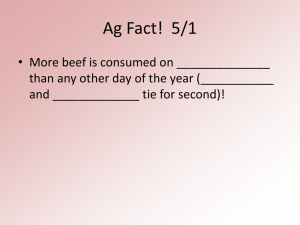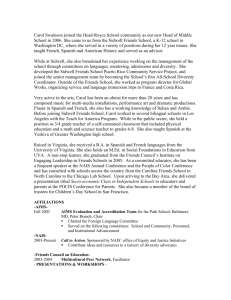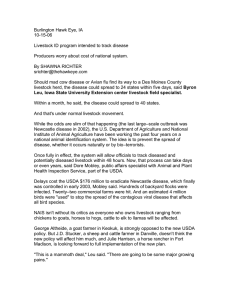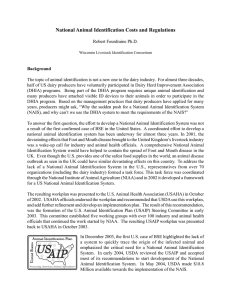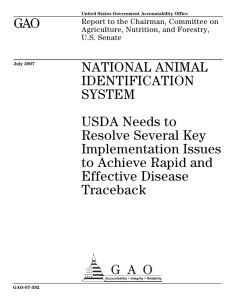AG-ECO NEWS Jose G. Peña Professor & Extension Economist-Management
advertisement
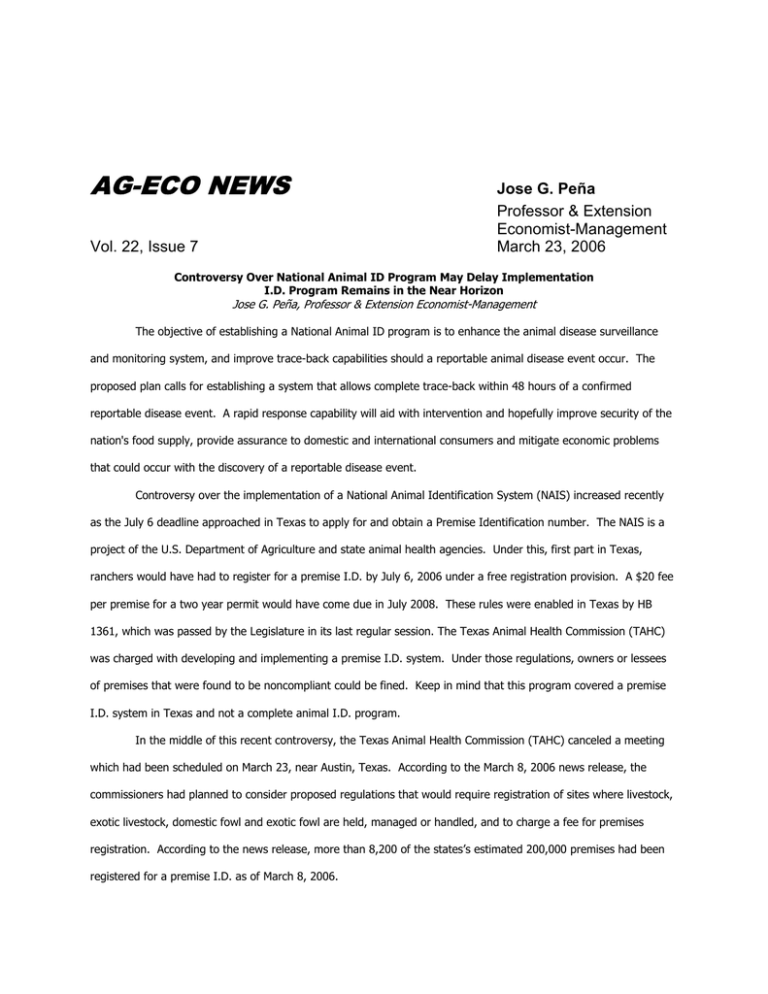
AG-ECO NEWS Vol. 22, Issue 7 Jose G. Peña Professor & Extension Economist-Management March 23, 2006 Controversy Over National Animal ID Program May Delay Implementation I.D. Program Remains in the Near Horizon Jose G. Peña, Professor & Extension Economist-Management The objective of establishing a National Animal ID program is to enhance the animal disease surveillance and monitoring system, and improve trace-back capabilities should a reportable animal disease event occur. The proposed plan calls for establishing a system that allows complete trace-back within 48 hours of a confirmed reportable disease event. A rapid response capability will aid with intervention and hopefully improve security of the nation's food supply, provide assurance to domestic and international consumers and mitigate economic problems that could occur with the discovery of a reportable disease event. Controversy over the implementation of a National Animal Identification System (NAIS) increased recently as the July 6 deadline approached in Texas to apply for and obtain a Premise Identification number. The NAIS is a project of the U.S. Department of Agriculture and state animal health agencies. Under this, first part in Texas, ranchers would have had to register for a premise I.D. by July 6, 2006 under a free registration provision. A $20 fee per premise for a two year permit would have come due in July 2008. These rules were enabled in Texas by HB 1361, which was passed by the Legislature in its last regular session. The Texas Animal Health Commission (TAHC) was charged with developing and implementing a premise I.D. system. Under those regulations, owners or lessees of premises that were found to be noncompliant could be fined. Keep in mind that this program covered a premise I.D. system in Texas and not a complete animal I.D. program. In the middle of this recent controversy, the Texas Animal Health Commission (TAHC) canceled a meeting which had been scheduled on March 23, near Austin, Texas. According to the March 8, 2006 news release, the commissioners had planned to consider proposed regulations that would require registration of sites where livestock, exotic livestock, domestic fowl and exotic fowl are held, managed or handled, and to charge a fee for premises registration. According to the news release, more than 8,200 of the states’s estimated 200,000 premises had been registered for a premise I.D. as of March 8, 2006. Also, according to the news release, the Commission is scheduled to meet on Thursday, May 4 but that it is too early to know whether the proposed regulations will be considered at that meeting. Opposition to establish a NAIS is quite complex, but appears centered around privacy issues and the increased implementation costs which could be past to producers. Voluntary I.D. Program While the current NAIS program has been under development since 2002 by a public/private partnership with the National Institute for Animal Agriculture, discussions to establish a livestock I.D. program have been underway for over 20 years. The implementation of a program was accelerated by the December ‘03 bovine spongiform encephalopathy (BSE) incident. On December 31, 2003, Agriculture Secretary Ann Veneman called for the creation of a nationwide animal identification system. Congress has not passed legislation mandating an NAIS. As a result, an NAIS remains voluntary. While a voluntary program is currently in place, plans are underway for a mandatory identification program by 2009. The current concept appears to be to establish an NAIS in phases; voluntary premises registration first, followed by mandatory registration, then animal registration, and finally, animal movement detection. Enforcement would include fines of up to $1,000 per day for non-compliance. Congressmen Grassley, R-IA, when speaking about a mandatory national program for trading livestock, said recently, “Either you have somebody in the U.S. Department of Agriculture with guts enough to make a decision that we’re moving forward or else Congress is going to have to act.” A required identification system may likely lead to structural changes in the cattle industry. For example, cattle marketability will hinge on having a viable animal ID system in place. An identification system will call for additional management and record keeping requirements. Recent concerns about animal disease outbreaks, food safety, and agricultural terrorism highlight the need for information about the movements of food and agricultural commodities into and within the United States. Livestock and meat are of special concern, given the potential health and economic impacts of diseases such as foot and mouth, bovine spongiform encephalopathy (BSE), anthrax, tuberculosis, and brucellosis. These concerns mean that a system of tracking livestock will be implemented. The recent BSE confirmed cases in Texas during June 2005 and in Alabama, earlier this month, reinforces the need for an animal I.D. program. For more information, visit the United States Animal Identification Plan (USAIP) Information Site at http://animalid.aphis.usda.gov/nais/subjects/animal_id/index.shtml.


